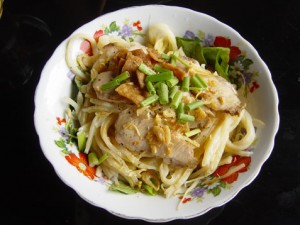 The historic trading town of Hoi An in Central Vietnam is a popular stop for tourists on the Saigon-Hanoi trail. Dutch, Chinese, Japanese, and Indian traders came to Hoi An to conduct business and exchange goods until the 17th century. While waiting for their ships to be unloaded, the traders would rest on the second floor of a riverfront restaurant with a view and enjoy a steaming bowl of cao lau noodles.
The historic trading town of Hoi An in Central Vietnam is a popular stop for tourists on the Saigon-Hanoi trail. Dutch, Chinese, Japanese, and Indian traders came to Hoi An to conduct business and exchange goods until the 17th century. While waiting for their ships to be unloaded, the traders would rest on the second floor of a riverfront restaurant with a view and enjoy a steaming bowl of cao lau noodles.
Trading and shipping have long since moved north to Da Nang, however cao lau is still a source of pride for locals in Hoi An. The unique noodle dish can only be made in Hoi An – all other renditions in Vietnam or elsewhere are not authentic.
Perhaps the differentiator between cao lau and other noodle dishes is the texture. Cao lau noodles are firmer and chewier – very similar to Japanese udon – than those found in typical Vietnamese noodle dishes such as pho.
Unlike pho, cao lau noodles are served with very little broth. The broth is seasoned with cilantro, basil, and mint; sometimes chili peppers and a lime are provided on the side. Cao lau should be served with salad greens and bean sprouts, although many restaurants leave these important ingredients out to save cost. Unless ordered vegetarian, thinly-sliced pork slices and deep-fried croûtons are sprinkled on top to complete the dish.
Why can’t cao lau be made anywhere else in Vietnam? The secret lies in the water; authentic cao lau is prepared only with water drawn from ancient Cham wells hidden around Hoi An and Quang Nam Province. Noodles are pre-soaked in well water and lye made from wood ash brought from one of the eight Cham Islands around 10 miles outside of Hoi An. The combination may seem esoteric, but local foodies can tell a difference in the taste and texture!
Cao lau literally appears on every menu around Hoi An – both in the Old Town and on streets outside. With every eatery in town advertising some interpretation of the dish, finding authentic cao lao can actually be daunting. Many restaurants leave out key ingredients or do not use well water; some places are cheeky enough to use pho broth thinking that tourists will not know the difference!
Real cao lau takes a long time to prepare. In fact, natives to Hoi An do not even attempt to prepare the dish at home, most opt to eat out and leave cao lau to the professionals.
The best bet for finding authentic cao lau in Hoi An is to eat from street vendors who only serve cao lau or a small handful of local dishes. Do not expect the real deal from tourist restaurants along the river with menus as thick as phone books.
If you do not mind the hassle and hectic environment, authentic cao lau can be purchased from stalls in the outdoor market on the east end of Bach Dang Street along the river. Otherwise, try your luck by approaching one of the handful of restaurants that also operate a cooking school; many schools have students prepare authentic cao lau as part of the course.
Despite the preparation time, cao lau is usually cheap to eat – under $2 a bowl. Although cao lau is served in most restaurants until close, locals prefer to eat the dish either for breakfast or lunch, giving plenty of time to digest the firm noodles.
Tradition claims the only true way to enjoy cao lau is to eat it on the second floor of a restaurant, just as the traders did hundreds of years ago. Your height above sea level won’t have much bearing on the delicious taste, but looking out over the same river while enjoying the same taste that merchants did centuries ago is highly addictive!